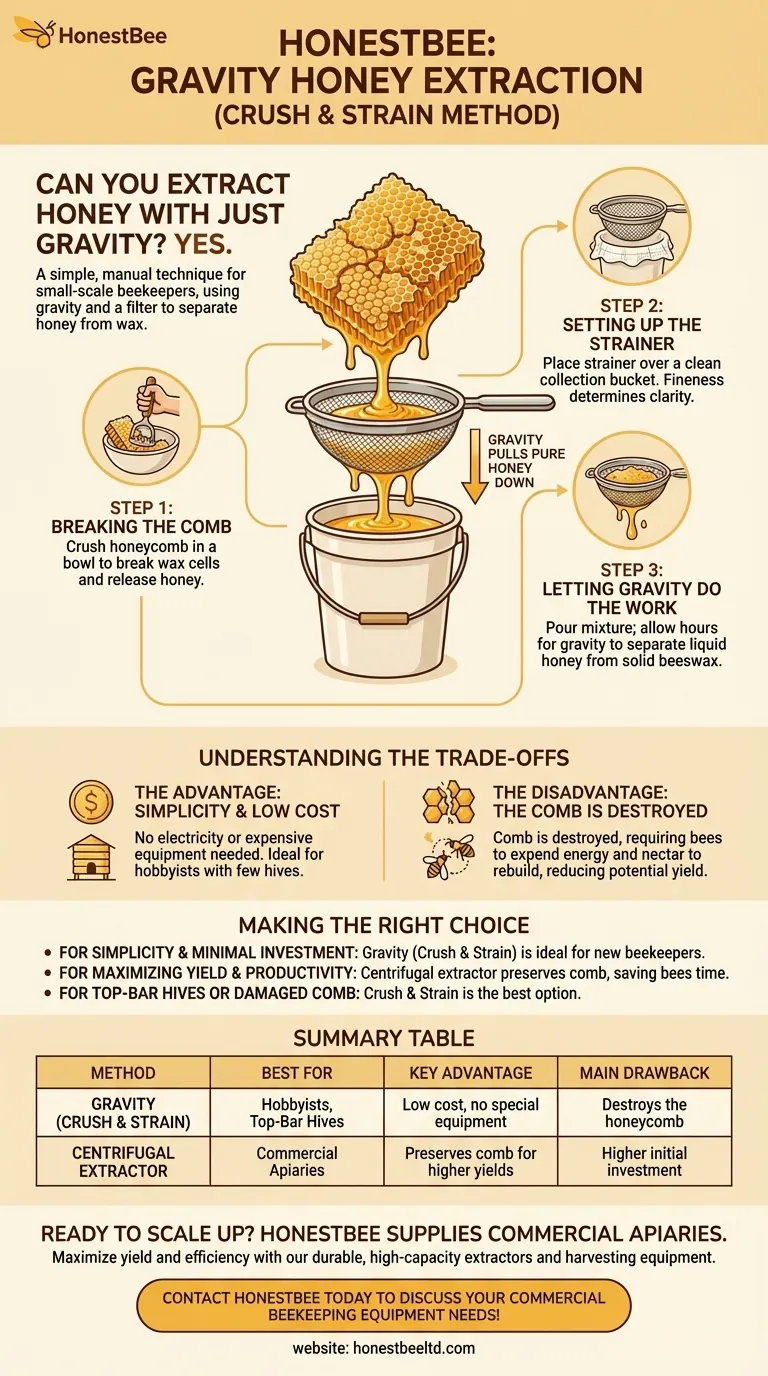Yes, you absolutely can extract honey using only gravity. This process, known as the "crush and strain" method, is a simple, manual technique ideal for small-scale beekeepers. It works by breaking up the honeycomb to release the honey and then using a filter and gravity to separate the liquid honey from the solid beeswax.
The core principle of gravity extraction is straightforward: crush the honeycomb to break open the wax cells and then let the mixture drip through a strainer. Gravity pulls the pure honey down, leaving the beeswax behind.

How the Crush and Strain Method Works
The crush and strain method is the oldest and most fundamental way to harvest honey. It requires minimal equipment and relies on simple physical principles rather than mechanical force.
Step 1: Breaking the Comb
The first step is to release the honey from the thousands of individual wax cells that make up the honeycomb. You place the comb into a food-grade bucket or large bowl.
Using a clean tool, like a large spoon or a potato masher, you simply crush the comb. This action breaks the delicate wax structure, allowing the viscous honey to flow freely.
Step 2: Setting Up the Strainer
Next, you prepare for the separation. This involves placing a strainer or layers of cheesecloth over the opening of a clean, food-grade collection bucket.
The fineness of your filter will determine the final clarity of your honey. A coarser filter will work faster but may let small particles of wax through, while a finer filter will result in cleaner honey but take longer.
Step 3: Letting Gravity Do the Work
You then pour the entire mixture of crushed wax and honey into the strainer. There is no machine or spinning involved.
Over the next several hours, or even up to a day, gravity slowly pulls the liquid honey down through the filter and into the collection bucket below. The solid pieces of beeswax are left behind in the strainer.
Understanding the Trade-offs
While simple, the crush and strain method involves a critical trade-off that every beekeeper must consider. Its primary advantage is also directly linked to its main disadvantage.
The Advantage: Simplicity and Low Cost
This method is accessible to anyone. It requires no electricity and no expensive equipment like a centrifugal extractor or an uncapping knife. This makes it the perfect starting point for hobbyists with only one or two hives.
The Disadvantage: The Comb is Destroyed
The most significant drawback is that this process completely destroys the drawn beeswax comb. Bees expend an enormous amount of energy and consume a large quantity of nectar to build this intricate structure.
When the comb is preserved, as it is with centrifugal extraction, the bees can immediately begin refilling it with honey. When it's destroyed, they must start from scratch, which can significantly reduce the hive's potential honey production for the season.
Making the Right Choice for Your Goal
Deciding between gravity extraction and other methods depends entirely on your scale, resources, and beekeeping philosophy.
- If your primary focus is simplicity and a minimal initial investment: The crush and strain method is the ideal choice for a new beekeeper or someone with only a few hives.
- If your primary focus is maximizing bee productivity and long-term honey yield: Investing in a centrifugal extractor is better because preserving the comb saves your bees critical time and energy.
- If you are harvesting from a frameless top-bar hive or have damaged comb: Crush and strain is your best and often only practical option, as this type of comb cannot be used in an extractor.
Ultimately, understanding this fundamental trade-off empowers you to choose the extraction method that best aligns with your specific goals.
Summary Table:
| Method | Best For | Key Advantage | Main Drawback |
|---|---|---|---|
| Gravity (Crush & Strain) | Hobbyists, Top-Bar Hives | Low cost, no special equipment | Destroys the honeycomb |
| Centrifugal Extractor | Commercial Apiaries | Preserves comb for higher yields | Higher initial investment |
Ready to scale up your honey harvest?
For commercial apiaries and beekeeping equipment distributors, maximizing yield and efficiency is key. While the crush and strain method is great for hobbyists, professional operations require professional equipment to preserve comb and maximize productivity.
HONESTBEE supplies the durable, high-capacity extractors and harvesting equipment that commercial beekeepers rely on. Our wholesale-focused operations ensure you get the reliable tools you need to succeed.
Contact HONESTBEE today to discuss your commercial beekeeping equipment needs and boost your operation's efficiency!
Visual Guide

Related Products
- Stainless Steel Double Layer Honey Strainer Sieve Filters
- Conical Nylon Honey Strainer Filter Bag for Beekeeping and Honey Filtration
- 10L Stainless Steel Electric Honey Press Machine
- HONESTBEE 72 Frame Industrial Electric Honey Extractor for Beekeeping
- 0.5T Capacity Honey Dehumidifier Dryer with Vacuum Heating and Thickening Filtering Machine
People Also Ask
- What is a steel strainer used for? A Kitchen Essential for Precision & Hygiene
- What is a honey strainer used for? Clean, Clear Honey for Hobbyists & Small-Scale Beekeepers
- What are the key features of a double sieve honey strainer? Achieve Fast, Clean Honey Processing
- What is the best material for straining honey? Achieve Pure, High-Quality Honey with the Right Materials
- Why is straining important in honey harvesting? Ensure Clean, High-Quality Raw Honey



















